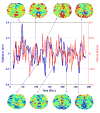The global signal in fMRI: Nuisance or Information?
- PMID: 28213118
- PMCID: PMC5406229
- DOI: 10.1016/j.neuroimage.2017.02.036
The global signal in fMRI: Nuisance or Information?
Abstract
The global signal is widely used as a regressor or normalization factor for removing the effects of global variations in the analysis of functional magnetic resonance imaging (fMRI) studies. However, there is considerable controversy over its use because of the potential bias that can be introduced when it is applied to the analysis of both task-related and resting-state fMRI studies. In this paper we take a closer look at the global signal, examining in detail the various sources that can contribute to the signal. For the most part, the global signal has been treated as a nuisance term, but there is growing evidence that it may also contain valuable information. We also examine the various ways that the global signal has been used in the analysis of fMRI data, including global signal regression, global signal subtraction, and global signal normalization. Furthermore, we describe new ways for understanding the effects of global signal regression and its relation to the other approaches.
Keywords: General linear model; Global signal; Motion; Physiological noise; Vigilance; fMRI.
Copyright © 2017 Elsevier Inc. All rights reserved.
Figures








References
-
- Aguirre GK, Zarahn E, D’esposito M. Empirical analyses of BOLD fMRI statistics. II. Spatially smoothed data collected under null-hypothesis and experimental conditions. NeuroImage. 1997 Apr;5(3):199–212. - PubMed
-
- Aguirre GK, Zarahn E, D’esposito M. The inferential impact of global signal covariates in functional neuroimaging analyses. NeuroImage. 1998 Oct;8(3):302–306. - PubMed
-
- Amemiya S, Kunimatsu A, Saito N, Ohtomo K. Cerebral hemodynamic impairment: assessment with resting-state functional MR imaging. Radiology. 2014 Feb;270(2):548–555. - PubMed
Publication types
MeSH terms
Grants and funding
LinkOut - more resources
Full Text Sources
Other Literature Sources
Medical

